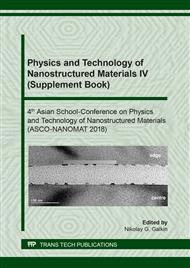[1]
M. Otto, M. Algasinger, H. Branz, B. Gesemann, Th. Gimpel, K. Füchsel, Th. Käsebier, S. Kontermann, S. Koynov, X. Li, V. Naumann, J. Oh, A. N. Sprafke, J. Ziegler, M. Zilk, and R. B. Wehrspohn, Black Silicon Photovoltaics, Adv. Optical Mater. 3 (2015) 147–164.
DOI: 10.1002/adom.201400395
Google Scholar
[2]
T. Her, R.J. Finlay, C. Wu, S. Deliwala, E. Mazur, Microstructuring of silicon with femtosecond laser pulses, Appl. Phys. Lett. 73 (1998) 1673–1675.
DOI: 10.1063/1.122241
Google Scholar
[3]
J. Yoo, Y.U. Gwonjong, Y.I. Junsin, Large-area multicrystalline silicon solar cell fabrication using reactive ion etching (RIE), Sol. Energy Mater Sol Cells. 95 (2011) 2–6.
DOI: 10.1016/j.solmat.2010.03.029
Google Scholar
[4]
Y. Qu, L. Liao, Y. Li, H. Zhang, Y. Huang and X. Duan, Electrically conductive and optically active porous silicon nanowires, Nano Lett. 9(12) (2009) 4539-4543.
DOI: 10.1021/nl903030h
Google Scholar
[5]
S. Liu, C. Palsule, S. Yi, S. Gangopadhyay, Characterization of stain-etched porous silicon, Phys. Rev. B. 49 (15) (1994) 10318-10325.
DOI: 10.1103/physrevb.49.10318
Google Scholar
[6]
C. M. A. Ashruf, P. J. French, P. M. M. C. Bressers, P. M. Sarro, J. J. Kelly, A new contactless electrochemical etch-stop based on a gold/silicon/TMAH galvanic cell, Sens. Actuators A: Phys.66 (1) (1998) 284-291.
DOI: 10.1016/s0924-4247(97)01711-1
Google Scholar
[7]
X. Li and P. W. Bonn, Metal-assisted chemical etching in HF:H2O2 produces porous silicon, Appl. Phys. Lett. 77 (2000) 2572-2574.
DOI: 10.1063/1.1319191
Google Scholar
[8]
C. Chartier, S. Bastide, C. Lévy-Clément, Metal-assisted chemical etching of silicon in HF-H2O2, Electrochimica Acta. 53 (17) (2008) 5509-5516.
DOI: 10.1016/j.electacta.2008.03.009
Google Scholar
[9]
K. Kolasinski, The mechanism of galvanic/metal-assisted etching of silicon, Nanoscale Research Letters. 9(1) (2014) 432-439.
DOI: 10.1186/1556-276x-9-432
Google Scholar
[10]
O.V. Volovlikova, S.A. Gavrilov, A.V. Sysa, A.I. Savitskiy, A.Yu. Berezkina, Ni-activated photo-electrochemical formation of por-Si in HF/H2O2/H2O Solution, Proceedings of the 2017 IEEE Russia Section Young Researchers in Electrical and Electronic Engineering Conference, (2017) 1213-1216.
DOI: 10.1109/eiconrus.2017.7910779
Google Scholar
[11]
Z. Yue, H. Shen, Y. Jiang et al., Formation and mechanism of silicon nanostructures by Ni-assisted etching, J Mater Sci: Mater Electron. 25(3) (2014) 1559-1563.
DOI: 10.1007/s10854-014-1768-7
Google Scholar
[12]
P. Narayanan. Photoelectrochemical etching of isolated, high aspect ratio microstructures in n-type silicon (100),, A Thesis, (2007).
DOI: 10.31390/gradschool_theses.4273
Google Scholar
[13]
M. Lipinski, J. Cichoszewski, R.P. Socha, and T. Piotrowski, Porous Silicon Formation by Metal-Assisted Chemical Etching, Acta Phys. Polon. A. 116 (2009) 117-119.
DOI: 10.12693/aphyspola.116.s-117
Google Scholar
[14]
H. Han, Z. Huang, W. Lee, Metal-assisted chemical etching of silicon and nanotechnology applications, NanoToday. 9 (2014) 271-304.
Google Scholar
[15]
A.E. Sanli, A. Aytaç, Electrochemistry of the Nickel Electrode as a Cathode Catalyst in the Media of Acidic Peroxide for Application of the Peroxide Fuel Cell, ECS Transactions. 42 (1) (2012) 3-22.
DOI: 10.1149/1.4705474
Google Scholar
[16]
N.M. Ravindra, S.R. Marthi, S. Sekhri, Modeling of optical properties of black silicon/crystalline silicon, J Sci Ind Metrol. 1(1) (2015) 1.
Google Scholar
[17]
G. Barillaro, P. Bruschi, A. Diligenti, A. Nannini, Fabrication of regular silicon microstructures by photo-electrochemical etching of silicon, Physica Status Solidi (C). 2(9) (2005) 3198 – 3202.
DOI: 10.1002/pssc.200461110
Google Scholar
[18]
V. Chamard, S. Setzu, R. Romestain, Light assisted formation of porous silicon investigated by X-ray diffraction and reflectivity, Applied Surface Science. 191 (1-4) (2002) 319-327.
DOI: 10.1016/s0169-4332(02)00256-8
Google Scholar
[19]
C. Pickering, M.I.J. Beale, D.J. Robbins, P.J. Pearson, R. Greef, Optical properties of porous silicon films, Thin Solid Films. 125 (1-2) (1985) 157-163.
DOI: 10.1016/0040-6090(85)90408-0
Google Scholar
[20]
W. Theibeta, S. Henkel, M. Arntzen, Connecting microscopic and macroscopic properties of porous media: choosing appropriate effective medium concepts, Thin Solid Films. 255 (1995) 177–180.
DOI: 10.1016/0040-6090(94)05649-x
Google Scholar


